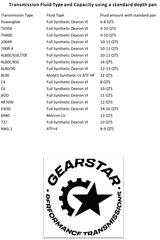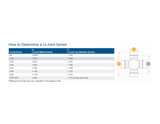Dyno Tune Your Trans
Running your trans on a dyno before it gets bolted in your car will save you lots of headaches and ensure flawless performance. By Stephen Kim
Whether they're used as precision tuning instruments or as obligatory instruments of bragging, the purpose of a dyno is to triumph in numerical glory. Even real racers and bench racers can both agree on that one. Consequently, like an oil field that goes undrilled in an arctic hellhole, the notion of a dyno that can't measure power is beyond absurd. While a transmission dyno is such a device, it's far from useless. By simulating the varying loads, rpm, and road speeds that a transmission will experience in a car, trans dynos are an essential tool for fine-tuning and troubleshooting teething issues before a slushbox is bolted behind your motor.
Not only can trans dynos accurately dial in converter stall speed to within 150 rpm, they can also be used to set shift points and firmness, seat fresh bands and friction materials, verify smooth and leak-free operation, and check for leaks and proper operating pressure. In essence, the process eliminates guesswork and promotes longevity. "A transmission dynamometer is an indispensable must-have tool for any serious transmission shop," says Zack Farah of Gearstar. "It allows quick access to critical components like the pan, valvebody, governor, shift solenoids, and pressure regulators, which greatly simplifies the calibration process. Even if you meticulously assemble an automatic trans with high-quality components, there are so many moving parts inside that they're rarely perfect when they're first assembled. That's why we prefer to work out the bugs on our dyno instead of having the customer be the guinea pig."
To get a better idea of how the testing procedure goes down, we watched as Gearstar ran a freshly built GM 4L65E through its exhausting testing and tuning procedure on the company's Hicklin Axline dyno. It was an enlightening experience, and certainly reinforced why Gearstar goes through the effort to dyno test every transmission they build. Here's a step-by-step account of the dyno testing process along with some background information on how dynos work.
THE LAYOUT
In order for test results to have any validity, a trans dyno must precisely replicate how torque is transferred from the flexplate and converter through the transmission. The two key components are the engine, in this case a mild small-block Chevy, and the power absorption unit attached to the transmission tailshaft. As with an engine dyno, the motor has its own dedicated fuel and cooling system. The front of the transmission bolts to a 360-degree turret, and crankshaft with a coupler. Inside the dyno unit is a fluid reservoir, heat exchanger, and a pump that supplies hydraulic pressure to the trans.
The heart of the system is an 800-pound inertia damper flywheel that attaches to the output shaft of the trans through a short driveshaft. Essentially an eddy-current power absorption unit, it simulates the load a transmission experiences in a car. The damper can vary loads equivalent to vehicle weights ranging from 2,200 to 4,000 pounds, and compensate for different ring-and-pinion ratios as well. "This enables us to see exactly how a torque converter is going to stall in a specific car, which is important because all of our transmissions are custom-built to order," explains Zack. "That way, we can match up stall speed perfectly to any given application with no guesswork involved."
SYSTEM OPERATION
With a plethora of gauges and the responsibility of operating both a motor and transmission simultaneously, multi-tasking skills are imperative to properly work a transmission dyno. To help operate the motor, the instrument panel features an ignition switch, a throttle handle, and gauges to monitor fluid temperature and pressure, and a tach. On the transmission side, gauges report hydraulic line pressure, output shaft rpm, and road speed. The operator must juggle between applying throttle with one hand and shifting gears with the other while keeping a close eye on all gauges. Gearstar runs each transmission it builds up to 130 mph, and logs the equivalent of 60-100 road miles during each test. Each dyno session lasts between 45 to 90 minutes.
The test procedure begins with line pressure set at a minimum to help prime the system and seat the bands and friction materials. Line pressure is gradually increased, and then a part-throttle run is performed while shifting through the gears manually. Next, a series of pulls are made at WOT in both manual and automatic modes. Shift points and shift firmness are then adjusted to each customer's specifications. All the while, the operator looks and listens closely for leaks, vibrations, and any strange noises. "Another benefit of dyno testing is that we break in the trans for our customer, and drain all the metal particles out of the pan," says Zack. "When our transmissions ship, they're literally ready to go right out of the box."
INSIDE GEARSTAR
If having invested over $100,000 in dyno equipment is any indication, Gearstar owner Zack Farah is serious about building top-notch performance transmissions. He's been in the business for over 28 years, and got his start at Tri Star International, a company that built over 100 transmissions and 300 torque converters every day. The bulk of Tri Star's production was as an OEM supplier, but Zack found it too mundane and decided to open up a shop specializing in high-performance transmissions. "I've always liked the challenge of meeting the demands placed on hot rods." He explains. Seeking to fill a void in the market, Zack took the unique approach of custom-building each transmission to each specific application based on power output, vehicle weight, cam specs, rear tire diameter, rearend gear ratio, speedo type, and vehicle use. Likewise, in order to dedicate the effort he feels each transmission deserves, Zack takes the unique approach of assigning each of his builders to one transmission from start to finish. That means that each builder is responsible for the transmission from the time the order is taken, throughout the entire build process, and until the unit has been installed in the customer's car. "Each builder inscribes his initials on each transmission he builds, and this entire approach ensures that the customer receives a quality product. Over the years, we've had less than a 1 percent return rate."


